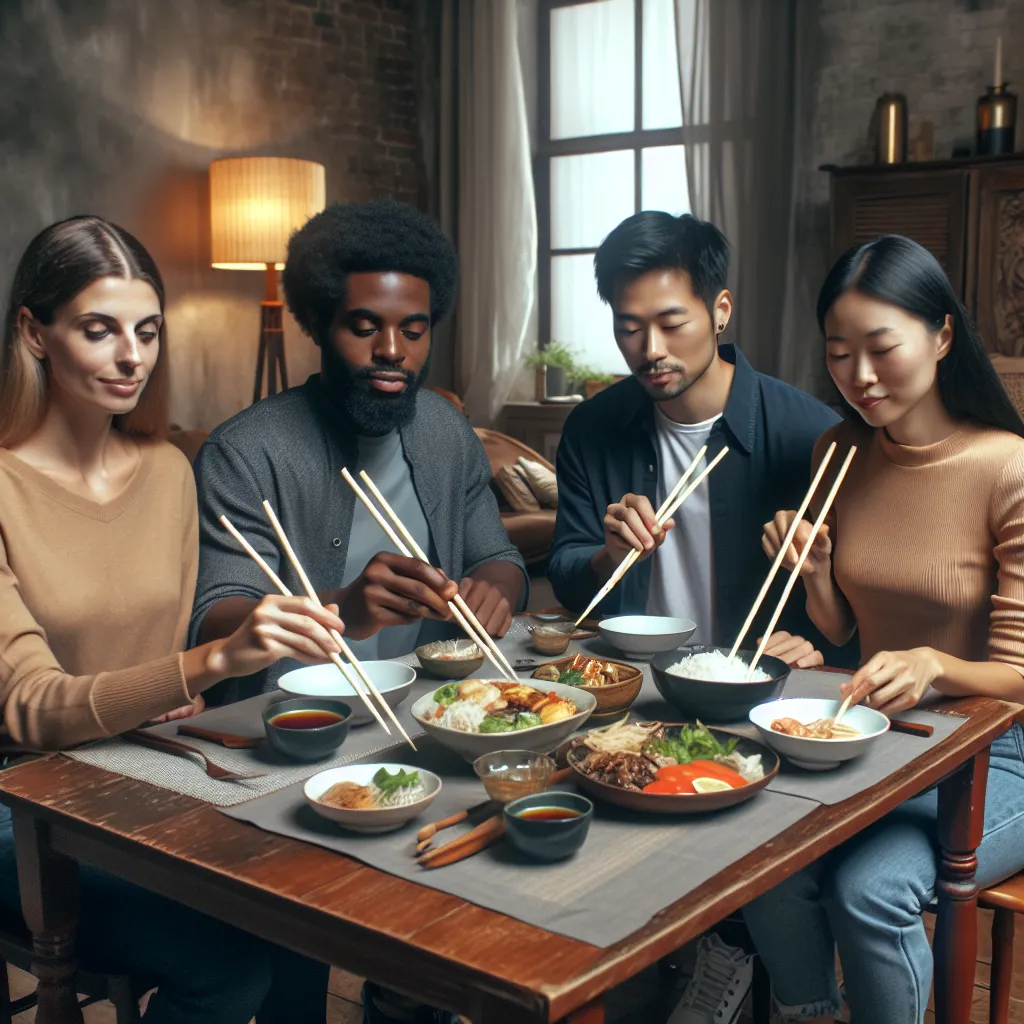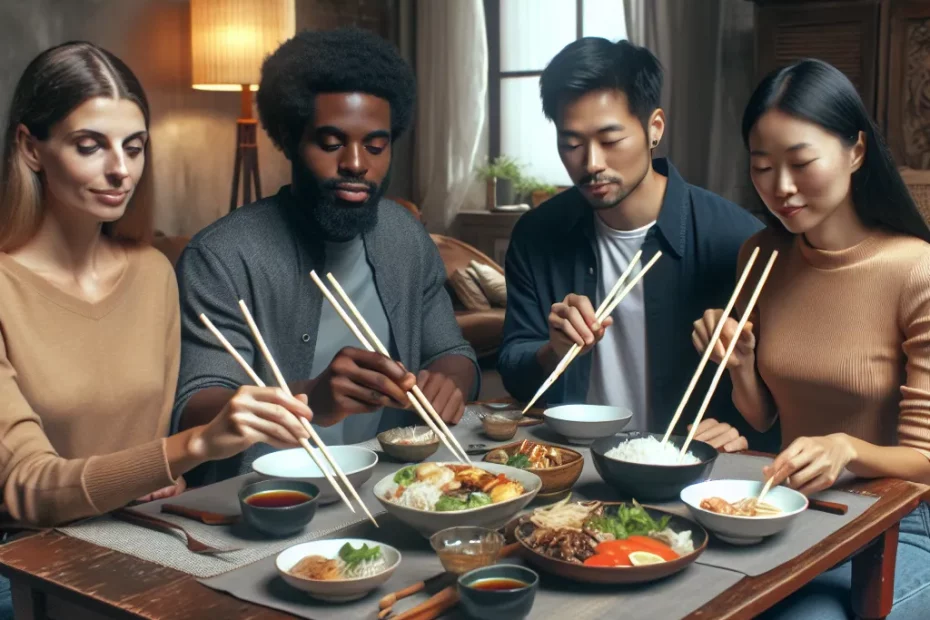As we gather around the dining table, it’s essential to understand the nuances of chopstick etiquette to avoid any embarrassing moments. Whether you’re a novice or a seasoned chopstick user, knowing the basics and proper handling techniques can make a significant difference in your dining experience. From common mistakes to cultural variations, navigating chopstick etiquette can be both fascinating and crucial in various social settings. Let’s delve into the world of chopsticks and explore how a little knowledge and practice can go a long way in making your dining experience more enjoyable and respectful. Let’s embark on this cultural journey together and discover the art of chopstick etiquette!

Chopstick Basics & History
Hey there, chopstick enthusiasts! Today, let’s dive into the fascinating world of chopsticks and uncover some interesting facts about their basics and history. 🥢✨
The Basics of Using Chopsticks
First things first, let’s talk about the basics of using chopsticks. Did you know that chopsticks are believed to have originated in ancient China over 5,000 years ago? That’s right, these handy utensils have been around for millennia, evolving into different styles and materials across various Asian cultures. From sleek and modern designs to traditional and ornate chopsticks, there’s a wide range to choose from!
Now, when it comes to using chopsticks like a pro, proper etiquette is key. Remember to never point your chopsticks at others, as it’s considered impolite. Instead, use them to pick up food gracefully and avoid making loud noises while eating. And don’t worry if you’re not a chopstick expert yet – practice makes perfect!
The History of Chopsticks
As we delve into the history of chopsticks, it’s fascinating to learn how they have become an integral part of Asian dining culture. In ancient times, chopsticks were initially used for cooking, serving, and eating food. Over the years, they became a symbol of social status and refinement, with different materials like bamboo, wood, metal, and even ivory being used to craft these utensils.
Fast forward to the present day, and chopsticks are not only practical tools for enjoying a delicious meal but also a cultural symbol that brings people together around the dining table. Whether you’re savoring sushi in Japan, slurping noodles in China, or enjoying bibimbap in Korea, using chopsticks adds an extra element of authenticity to the dining experience.
So, the next time you sit down for a meal with chopsticks in hand, remember the rich history and cultural significance behind these humble utensils. Embrace the art of chopstick etiquette, savor each bite with finesse, and enjoy the unique experience of dining Asian-style. 🍜🥢
There you have it, a glimpse into the world of chopstick basics and history. Stay tuned for more fun facts and tips on mastering the art of chopsticks! 😉
Common Chopstick Etiquette Mistakes
Are you a chopstick pro or do you sometimes fumble with these handy utensils? Whether you’re a chopstick novice or a seasoned user, it’s easy to make etiquette mistakes that can lead to some awkward dining moments. Let’s dive into some common chopstick blunders that you might want to avoid:
Crossing Chopsticks
🍜 Crossing Chopsticks: Have you ever crossed your chopsticks while placing them on the table? This is a big no-no in many Asian cultures as it symbolizes death and is considered extremely disrespectful. Always lay your chopsticks parallel to each other or use a chopstick rest if provided.
Stabbing Food
🍣 Stabbing Food: Using chopsticks to stab food like you would with a fork is another mistake to steer clear of. Chopsticks are meant for picking up food delicately, not for spearing it like a weapon. Embrace the pinch and lift technique instead.
Passing Food
🥢 Passing Food: When sharing dishes with others, avoid passing food from chopstick to chopstick. This action resembles a funeral ritual in some cultures and is best avoided. Instead, place the food on the recipient’s plate or use serving utensils.
Standing Chopsticks
🍚 Standing Chopsticks: Sticking your chopsticks upright in a bowl of rice is a major taboo. In Asian customs, this act is reminiscent of ancestral rituals involving incense sticks and is considered highly offensive. Always lay your chopsticks flat on the rest or beside your bowl.
Sucking Chopsticks
🍤 Sucking Chopsticks: Licking or sucking on your chopsticks is seen as impolite and unsanitary. Keep your chopsticks clean and dry, and avoid using them to gesture or point at others. Remember, they’re for eating, not for playing.
By steering clear of these common chopstick etiquette mistakes, you can enjoy your dining experience with confidence and grace. So, next time you reach for those chopsticks, remember these tips to ensure a smooth and respectful mealtime! 🥢
Proper Chopstick Handling Techniques
Are you ready to elevate your chopstick game and impress everyone at the dining table? Mastering the art of chopstick etiquette is not only about showcasing your skills but also about showing respect for the culture. Let’s dive into some proper chopstick handling techniques that will help you avoid any embarrassing moments and enjoy your meal to the fullest! 🥢✨
The Basics
1. The Basics: Before we get into the nitty-gritty details, let’s start with the basics. Hold one chopstick between your thumb and index finger, and rest it on the base of your thumb. Use your middle finger to support the chopstick. The other chopstick should be held between your index and middle fingers, with your thumb supporting it. Practice this grip to get comfortable with it.
The Correct Movement
2. The Correct Movement: When using chopsticks, the movement should come from your index and middle fingers, not your entire hand. Keep the first chopstick stationary and use the second chopstick to pick up food by moving it towards the stationary one. This precise movement may take some practice, but you’ll get the hang of it!
Avoid Cross-Contamination
3. Avoid Cross-Contamination: One major etiquette rule is to avoid using the end of your chopsticks that touches the food to pick up more food from shared dishes. Instead, turn your chopsticks around to use the clean end or use serving chopsticks if available. This practice shows consideration for others at the table.
Resting Position
4. Resting Position: When taking a break from eating or finishing your meal, place your chopsticks parallel to each other on the chopstick rest or on the edge of your plate. Avoid sticking them vertically into your food, as this is reminiscent of a funeral ritual in some Asian cultures.
Passing Food
5. Passing Food: If you want to share food with someone else, never pass it directly from your chopsticks to theirs. Instead, use the end of your chopsticks to move the food onto their plate. This gesture is considered polite and respectful.
Practice Makes Perfect
6. Practice Makes Perfect: Like any skill, mastering chopstick handling techniques takes practice. Don’t be discouraged if you struggle at first. Keep practicing, and soon you’ll be able to impress everyone with your chopstick prowess!
By following these proper chopstick handling techniques, you’ll not only avoid any embarrassing moments at the dining table but also show respect for the cultural significance of using chopsticks. So, grab those chopsticks, practice away, and get ready to enjoy a delicious meal with confidence and finesse! 🍜🥢
Navigating Chopstick Etiquette in Different Cultures
Have you ever found yourself in a situation where you felt a bit lost when it comes to using chopsticks in a different culture? Don’t worry, you’re not alone! Chopstick etiquette varies across different cultures, and it’s easy to unintentionally offend someone if you’re not familiar with the customs. Let’s take a journey together to explore the fascinating world of chopstick etiquette in various cultures.
Chopstick Etiquette in Japan
In Japan, chopsticks are an essential part of dining etiquette. It’s important to hold your chopsticks correctly, avoid pointing them at others, and never pass food from chopstick to chopstick, as this is reminiscent of a funeral ritual. Remember to use the opposite end of your chopsticks when serving food to others as a sign of respect.
Chopstick Etiquette in China
In China, chopsticks hold symbolic importance, and there are several taboos to be aware of. Never leave your chopsticks sticking upright in a bowl of rice, as this resembles incense offerings made to the deceased. Instead, rest your chopsticks on a chopstick rest or the edge of your plate. When sharing dishes, use the serving chopsticks provided to transfer food to your plate to maintain hygiene.
Chopstick Etiquette in South Korea
South Korea also has its own chopstick etiquette rules. Avoid using your chopsticks to pierce food or make loud noises with them, as these actions are considered impolite. When receiving a drink from an elder, it’s customary to hold the glass with one hand and support your arm with the other hand as a sign of respect.
Each culture has its unique customs when it comes to chopstick etiquette, and being aware of these practices can help you navigate dining experiences with ease and grace. So, next time you find yourself faced with a pair of chopsticks, remember these tips to show respect for the culture you’re in and enjoy your meal to the fullest! Bon appétit!
As we navigate the intricate world of chopstick etiquette, it’s essential to approach it with an open mind and a willingness to learn. By understanding the basics, avoiding common mistakes, and practicing proper handling techniques, we can confidently enjoy meals without the fear of embarrassment. Remember, chopstick etiquette varies across cultures, so being respectful and observant is key. Embrace the cultural diversity and richness that chopsticks bring to the dining table. So, next time you sit down for a meal, let your chopsticks be an extension of your curiosity and respect for different customs. Happy dining!
